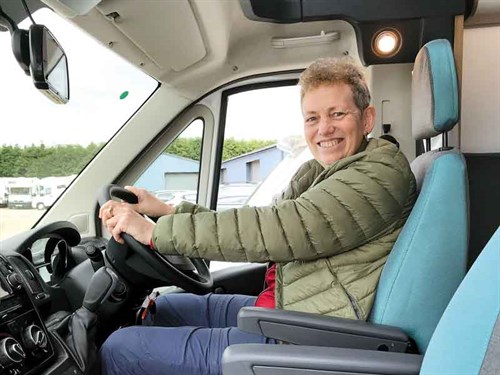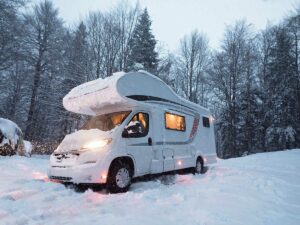Growing up in the UK, I have been fascinated by motorhomes from an early age and have always wanted one of my own. But, like many of us, over the years, other commitments got in the way, along with comments from well-meaning friends and family, such as “you won’t have time to use it”, “they depreciate so much”, and “where will you store it?”.

Even after I became a New Zealand resident in 1998, I kept looking at motorhomes with envy, read magazines, attended shows, and researched them online.
After a fair amount of research, I realised that as a New Zealander, I can buy a motorhome in the UK, use it there and in Europe while on holiday, and then export it home to New Zealand without paying UK VAT of 20 percent by using the Personal Export Scheme.
This was ideal for me. It would let me get the travel bug out of my system, connect with friends and family in the UK and Europe, and still have a motorhome when I came back.
So I decided to go for it. The rough plan was to choose and put a deposit on a vehicle before Christmas 2017 but pick it up in the UK in mid-April 2018 and travel around the UK and Europe for up to year.
I started researching options and created a spreadsheet to compare models, which helped narrow my search.
My list of ‘must-haves’ for the motorhome included:
- Being under 3.5 tonnes to be driven on a New Zealand licence in the UK.
- ESC (Electronic Stability Control) to comply with New Zealand regulations.
- A generous payload to allow me to have guests, hobbies, and drive legally without having to weigh everything I buy (see later).
- It couldn’t be so large that I couldn’t manage it. I began by looking at models under six metres, but the island bed requirement (see later) pushed this up a bit and I reset my limit to seven metres.
- I wanted a well-known, trusted brand and good dealer to minimise risk.
- A reversing camera was critical. I’ll be mostly on my own with no one to leap out and wave me backwards or see me round corners.
- At least three travel seats.
- At least two beds/sleeping areas, ideally three.
- Insulation, double glazing, and heating for all year and all-weather use.
In terms of layout, I needed one that would tick the following boxes:
- A bed that I wouldn’t have to make up each day.
- Supports my hobbies, such as a decent table for my art and good lighting.
- Ideally a garage to store a bike, outside chairs, table, barbecue, etc.
- Can sleep guests with some separation from me. At times, I may have a couple staying and at other times two single friends, so three beds would be ideal.
- Ideally, not a wet-room style shared shower/toilet. As I am full-timing, I may need to use the shower area to dry laundry but still want access to the toilet.
- Oven and/or grill as well as gas hobs. Being on my own, I won’t eat out a lot and being in the van full-time, I want flexibility.
There were two further must-haves that linked to my export plan. The first was the warranty. Those on a Fiat base have a worldwide base vehicle warranty but those on a Ford don’t. Mostly habitation warranties don’t apply if you export the vehicle. But the fact that some manufacturers offer longer water ingress warranties (for example) seemed reassuring.
The other was resale value. I know I’ll use my motorhome here but for how long? I don’t currently have a shed for storage, so I may use it for one season and then sell. This meant I needed a model with a good resale appeal here and this translated to an automatic transmission and an island bed.
It had to be automatic because that’s what most New Zealanders now drive. Watching online listings over time, I noticed that the automatics sold more quickly.
The New Zealand dealers I spoke with said most people looking to buy newer motorhomes are retiree couples who don’t want to deal with ladders for the night-time trip to the toilet, so an island bed was essential.
Other considerations that influenced my decisions included accessory bundles and deal pricing that affects total cost, interactions with dealers, and advice from trusted friends.
What I learned along the way
Payload is king. Payload is the difference between the maximum technically permissible load mass and the mass in running order (MIRO). Once you factor in the 3.5-tonne restriction, you realise some motorhomes don’t have sufficient payload to take the number of people they’re designed to carry and all the equipment needed for a holiday, let alone full-timing.
All manufacturers calculate the MIRO differently. For example, many just include a 75kg allowance for the driver and no fresh water. More people, accessories, food, water (fresh and grey), etc. need to be allowed for. This reduced greatly the manufacturers I was prepared to consider. Make sure payload is high on your list.
Most motorhomes sold in the UK are manual not automatic. This severely limits the choice and you may need to get a dealer to order from the manufacturer. This creates a time lag of about six months.
The spreadsheet helped me eliminate some models/suppliers. Availability of automatic transmission in the required time frame eliminated others.
My ideal choice was a Chausson motorhome on a Fiat Ducato base with an automatic transmission, but even with five months’ notice, this wasn’t an option. I could get it on a new Ford Transit but I’d heard mixed reports about the Ford transmission.
It would mean dealing with AdBlue diesel additive and the warranty wouldn’t apply back here. Other strong contenders were the Champagne range of Swifts from Brownhills as the accessory bundles made them attractive, but there wasn’t an island bed layout under seven metres.
I couldn’t have imagined there was so much to consider when buying a motorhome. But I’m pleased to say I found the perfect RV—a Sunliving from Adria. Now the fun really begins!
Coming up...
In Sue’s next article, she shares more about her new motorhome and talks us through the next steps of sorting insurance, joining clubs, and equipping her motorhome.





